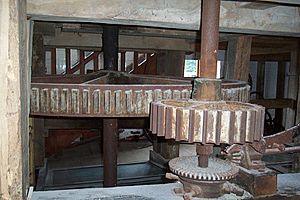Eling Tide Mill facts for kids
Quick facts for kids Eling Tide Mill |
|
|---|---|

The mill from beside mill pond, with the toll hut foreground.
|
|
| Location | Eling |
| OS grid reference | SU 36502 12520 |
| Area | Hampshire |
| Built | ca 1785 |
| Owner | New Forest District Council |
|
Listed Building – Grade II*
|
|
| Official name: Tide Mill | |
| Designated | 29 March 1959 |
| Reference no. | 1179062 |
| Lua error in Module:Location_map at line 420: attempt to index field 'wikibase' (a nil value). | |
Eling Tide Mill is a very special building located in Eling, Hampshire, England. It sits on a man-made path called a causeway. This mill is unique because it's one of only two working tide mills left in the United Kingdom. The other one is Woodbridge Tide Mill in Suffolk.
A mill was first mentioned here way back in 1086 in the Domesday Book. However, the mill you see today was rebuilt around 200 years ago. This happened after a big storm damaged the old one in the 1770s. Eling Tide Mill is now the main part of "The Eling Tide Mill Experience." This experience started in 2009 and includes the mill, a local heritage center, and outdoor walks. The site got its current name in 2018 after a three-year project to make it new again. This project was mostly paid for by the Lottery Fund. The mill is also a Grade II* listed building, which means it's a very important historic place.
How the Tide Mill Works
A tide mill uses the power of the ocean's tides to turn its wheels. Eling Tide Mill has two large waterwheels. Each wheel was designed to power two sets of millstones. These millstones grind grain into flour.
Today, one of the waterwheels and its millstones have been fixed up. They now work and produce flour that you can buy. The other waterwheel has been made to look nice, but it doesn't move. It's there so visitors can see all the parts of the mill's machinery up close. The working parts are covered for safety.
The mill can operate for about five to seven hours each day. This depends on when the tides are high enough to provide power.
History of Eling Tide Mill
For many years, Winchester College owned Eling Tide Mill. We know this because a lease from 1418 still exists. This paper shows that the College rented the mill to a man named Thomas Mydlington. He had to keep both the mill and the causeway in good condition.
The causeway, which is the path the mill sits on, often got damaged. For example, it was washed away in 1887. This problem continued until 1940. Engineers then figured out that the way the water gates (sluices) were built was causing the damage. They fixed this problem.
The people who rented the mill also had the right to collect money from vehicles using the causeway. In the past, four-wheeled vehicles paid 6d (which is about 2.5p today). Two-wheeled vehicles paid 4d. These prices stayed the same until 1970. More recently, the local council, Totton and Eling Town Council, has managed the toll. Today, it costs one pound per car to cross the causeway for a day.
In 1967, Tom Mackrell was the person collecting the tolls. He was also one of the last people to operate the mill before it closed in 1946. Tom worked for his brother Raymond, who was the master miller of Eling Tide Mill.
In 1975, Winchester College sold the mill to New Forest District Council for a very small amount of money. The mill was then repaired and reopened in 1980. It has been running as "The Eling Tide Mill Experience" ever since.


